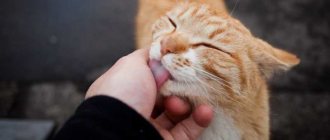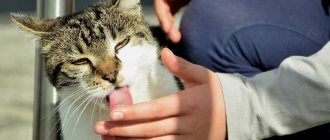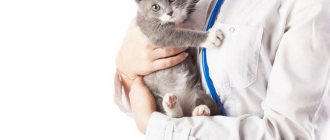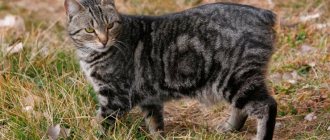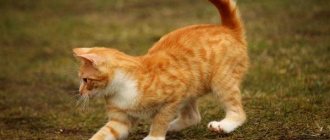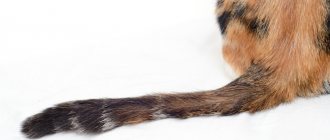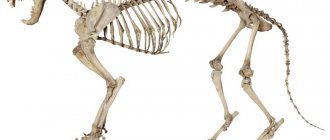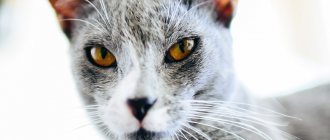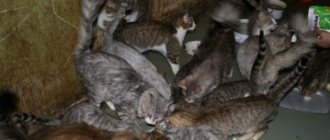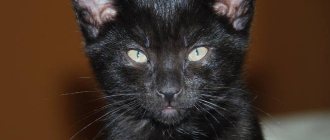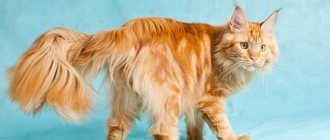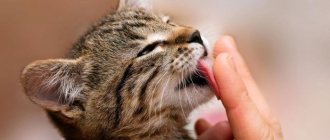Symptoms: how to determine if there is a problem
The fact that something is wrong with a cat’s tail will be visible to the naked eye.
A crease or unnatural bend will be visible at the site of injury. Also, often when injuries occur, the innervation is disrupted, and the animal is unable to move the injured part. The main signs of possible problems with a cat's tail are:
- visually noticeable fracture or disruption of integrity;
- pain when trying to touch the animal;
- traces of a bite, injury or infection are visible on the tail;
- a clearly noticeable inflammatory process and an increase in temperature, which can be detected even with a simple touch;
- the damaged part of the tail swells and swells;
- the tail hangs unnaturally;
- an open injury in which the bones are gaping;
- ensuing paralysis;
- problems with motor function of the legs are noticeable;
- problems with the toilet (either urinary and fecal incontinence appears, or the cat cannot defecate on its own).
An examination by a specialist will help you understand whether there is a fracture or whether it is a simple bruise.
If a cat tucks its tail, this is a clear sign of a problem. We observe and find out the reason
The cat's tail is a full-fledged part of the spine, a tool for maintaining balance and communication. If a cat tucks its tail, this is a clear sign of a problem. The cause can be determined by examination by a veterinarian and careful observation. Do not delay visiting a doctor, but if the condition is not acute, it is also unreasonable to rush. To determine the diagnosis, the doctor will need an anamnesis, which only the owner can provide.
Important! Having noticed that the pet holds its tail between its paws, does not sit down or does not sit down completely, you can make an unambiguous conclusion that the cat is in pain. In this case, consult a doctor immediately
Damage to the spine is fraught with a number of severe, irreversible consequences.
How cats communicate using their tails
It is not always possible to understand from the face how to determine the mood of the animal and figure out what the cat wants. And it is the cat’s tail that will tell you about all the thoughts and emotions of the pet. Let's look at specific examples of why and how a cat twitches its tail:
- The four-legged pet smoothly swings its tail horizontally in different directions. Cat experts indicate this gesture as the fact that she cannot immediately make a choice between her desires. When the decision is made, the animal will calm down and stop twitching;
- if a cat lifts its tail and puts it vertically, it tells you that the pet’s thoughts are very interested in something;
- a slight twitch indicates strong affection and love for you;
- if the cat’s fifth limb is down, it means that she is bored;
- the tail is up, but the back is arched and the ears are pressed back - the cat cannot decide whether to attack or defend. He is very scared;
- the tail is in a curved arc position and the cat arches its back - it senses danger and is ready to defend itself. In this state, do not hit her and try to calm her down;
- a tail raised up (vertically) indicates that the animal is in a great mood and is ready for games and communication;
- a loosely drooping tail tells that the pet is in a calm mood, but is not inclined to communicate;
- a measured and rather strong horizontal waving of the tail indicates dissatisfaction and irritation;
- a wary animal's tail is lowered and ruffled;
- only the tip of the tail moves slightly - at the moment the pet is in an excellent mood and is happy with everything that is happening around him;
- the cat’s tail trembles and moves horizontally in different directions faster and faster - the hunt is in full swing and an attack on the prey will occur in the coming seconds;
- a vertically extended, quivering tail denotes a playful mood. It’s worth considering here that if the movements become faster and sharper, the cat beats its tail and may start meowing - the animal is getting too excited and it’s time to stop it. This is especially true when playing with small children - the danger of scratches and bites from a cat is too great;
- a tail wrapped in a ring around the body speaks of an excellent mood and trust in the surrounding world;
- the tail is raised halfway - the pet is confused and cannot determine its attitude towards a person or animal - to understand whether it is a friend or an enemy;
- fluffy tail and fur along the spine - the cat is furious;
- a vertically raised tail may mean that the cat is marking territory;
- sharp waving or tapping indicates stress and possibly pain;
- biting the tail signals the presence of parasites;
- in cold weather, cats wrap their tail in a ring around themselves, thereby reducing heat transfer;
- a vertically raised tail with a relaxed tip indicates joyful excitement;
- sits or lies with the fifth limb calmly extended - the cat is resting;
- in a sitting position, with paws tucked and tail wrapped - the animal is relaxed, but waiting for some action;
- a slight twitching of the whole body along with the tail means happiness and calmness of the pet. You can observe this when stroking it, scratching its ears or back. Will also be expressed in loud purring and squinting of the eyes;
- a leisurely and rhythmic twitching of the tail vertically indicates interest in something. The cat is relaxed, does not feel danger and is concentrated on the object of its attention. It is also expressed in the fact that the animal walks around the object of its interest and sniffs it;
- the desire to attack can be expressed in walking the fifth limb from side to side. If this occurs when playing with inanimate objects, then there is no need to worry. As soon as the cat gets tired of this activity, it will move away from it and forget about it quite quickly. At least until the next surge in gaming activity.
Cats move their fifth limb almost constantly. There are many explanations for this fact.
When communicating, you just need to pay attention to your pet’s mood. When there is mutual understanding between the owner and the pet, when they can understand and feel each other, then there will be practically no problems in communication
Just listen to what your cat is telling you. Indeed, contrary to popular belief, tail twitching can also mean great love and devotion towards you.
The meaning of body movements
The cat is a graceful creature with developed muscles and amazing flexibility. It is easy for her to give her body any desired position and make a variety of movements. The ability to recognize these signs helps you understand exactly what your pet wants to tell you and what emotions he is experiencing. A cat can:
- to mark time;
- rub against legs;
- lie on your back, opening your stomach;
- bend and straighten paws;
- arch your back;
- curl up into a ball.
Quite often, cat owners notice how she begins to move her front paws, mark time, as if she is “kneading dough.” This movement indicates that the pet feels pleasant emotions and is comfortable. This habit has remained from an early age, when the kitten kneads its mother’s belly so that milk flows into the nipples. The owner can consider marking time a declaration of love.
Everyone understands that if a cat rubs against its legs, it communicates a feeling of affection and expresses gratitude. But such movements are not only a manifestation of positive emotions. The pet must leave its scent so that all other animals immediately understand that this is its owner.
With this gesture, the cat can ask the owner for food or say that it needs attention and affection.
In the language of animals, lying on your back means submission. If a cat takes this position, opens its tummy, it confesses its love and says that it completely trusts you. The owner may consider such a gesture as an expensive compliment.
A confident, calm, peaceful pet has straightened legs. If a dangerous situation arises, the cat “crouches.” Bent hind and front legs indicate that she does not want to fight, but if necessary, she will provide adequate protection. The animal can sit on its hind legs and stretch out in a column, like a gopher. The cat takes this position when it is overcome by curiosity and must understand what is happening.
It is easy to understand that an arched back is a challenge, a preparation for the upcoming battle. This gesture can be seen before cats fight. At the same time, the animals' ears flatten, their eyes open wide, and the hair on their tail and back stands on end. Cats can also arch their backs during play, thus demonstrating their readiness to attack.
A peaceful, calm pet curls up comfortably into a ball and rests. He is comfortable, he does not feel any danger. A relaxed position on the side with outstretched legs also speaks of calmness.
Learning cat language will help you communicate comfortably with your pet and know everything about its desires and emotions.
Authors of the articles: Belanta Clinic team
Symptoms and diagnosis
If the owner suspects damage to the tail of his pet, it is necessary to immediately find out how serious the problem is and whether it is really a pearl. Knowing the main symptoms of a tail fracture, the owner will be able to respond adequately:
The organ at the site of possible injury will be bent. Depending on the severity of the damage, the depth of the bend will depend. If the pearl is indeed present, then a kink in the tail will be evident. The tissue around the affected area will be swollen. Presence of a bleeding wound. Any touch to the injured part will cause severe pain to the animal. Increased temperature of the damaged organ and the whole body.
After an injury, the owner should keep an eye on the cat, because a fracture of the tail is not always accompanied by a clear bend. It may appear smooth, but the fact that the injury is serious will be indicated by the pet’s behavior and various signs.
The animal may have involuntary urination, and sometimes there is uncontrolled excretion of feces. But such symptoms do not always indicate that the cat has a broken tail. This is possible if the spine is damaged.
If it is confirmed that the pet has a tail fracture, he needs urgent hospitalization at the veterinary clinic. Doctors will use x-rays to diagnose and prescribe the necessary treatment. In difficult cases, if an animal’s tail injury has led to paralysis, an MRI, ultrasound, and blood test may be prescribed. Also, if the clinic has such a service, electromyography is prescribed. This is a method by which they determine how well nerve impulses travel through the muscles and peripheral nerves, that is, they determine the severity of the injury.
shutterstock
Cats take various manipulations calmly, but severe pain and the presence of strangers can provoke panic in the animal. It will be difficult to carry out a full diagnosis. In such cases, the veterinarian may decide that general anesthesia is necessary. In this way, he will make his work easier and the condition of the cat, who is experiencing torment.
Your cat's tail can tell you a lot
A cat's tail is a good indicator of her mood and can tell you what's going on in her head. Watch your cat for a while and you will gradually begin to understand the language of its tail.
Position: pipe tail.
Position: Tail raised, curved like a question mark
If you notice that the raised tail is curled, it may be time to take a break from what you're doing and pay attention to your cat. This tail position often signals that the cat is not at all opposed to playing with you.
Position: Tail down. Beware! A tail carried down can signal aggression. The cat is very serious. However, cats of some breeds, for example Persian, hold their tail in this position just like that - for them this is the norm.
Position: tail hidden. A tail wrapped around the hind legs and hidden under the body indicates fear or submission. Something is making your cat anxious.
Position: tail fluffed. A tail that resembles a chimney sweep indicates that the cat is extremely agitated and frightened, and is trying to appear larger to protect itself from danger.
Position: The cat beats its tail from side to side. If a cat beats its tail, quickly moving it from side to side, it thereby expresses both fear and aggression. This is a warning: “Don’t come near!”
Position: cat wagging its tail
If the tail moves slowly from side to side, this means that the cat has concentrated its attention on some object. This position of the tail indicates that the cat is about to pounce on a toy or piece of cat food that is away from the bowl.
Position: The cat has its tail wrapped around another cat. Just as people hug each other, cats wrap their tails around other animals. This is an expression of friendly sympathy.
Source
How to tell how a cat is feeling by its tail
The movements of a cat's tail can serve as an indicator of health. Having fallen ill, the animal will begin to make movements that were previously unusual for it. This is a sign that you need to take a closer look at your pet’s behavior and, if you notice other warning signs, contact your veterinarian.
The following table will help you understand what is happening in your pet’s body.
For all its simplicity, a cat's tail is capable of performing a wide variety of tasks. With its help, a pet can not only talk about its feelings, but also hint at its well-being
Therefore, it is so important for every responsible owner to know this special language.
If a cat raises its tail and shakes it, this gives an idea of more than just the condition of the pet. In this way, the furry animal expresses emotions during communication and lets the owner know what he wants and what he is ready for:
- When the animal is in a playful mood, the tail stands upright and twitches slightly. However, if the cat hits it on the floor, you should understand: the pet is irritated and no longer wants to continue the game.
- The cat's nervous irritation is indicated by a vertically raised tail like a pipe, but curved at the tip. In this state, it is better not to touch the pet: a blow with a paw with extended claws is a predictable reaction.
- If a cat sits, meows and makes small movements with its tail, this also indicates stress. But this may also be a consequence of pain, discomfort on the body or in the body.
- An angry cat is the easiest to identify. Rising fur, hissing and purring, as well as a sharply twitching tail, means that the predator is ready to attack and will respond to any awkward movement in its direction.
When a kitten shakes its tail, this may also mean it is time to mark its territory. The cat begins to mark and finely wags its tail, which becomes a natural reaction of the muscles to the act of the four-legged cat.
The behavior of a cat with a chaotically shaking tail can be attributed to ill health. If your pet begins to twitch its tail and shake its hind legs, you should see the animal to a veterinarian. Common causes include: pinched nerves, increased stress, inflammation of the anal glands, fleas, lice, inflammatory formations that cause painful discomfort.
Communicating with meowing companions is a cute thing. They never lie, they directly express thoughts, feelings, and intentions. Most of the information is conveyed by the position of the “fifth limb”. Here are the main cat messages and ways to convey them:
- the cat shakes its tail as if marking - a sign of stress, overexcitation during play, impatient anticipation, acute sexual experiences; Severe physical pain can manifest itself in this way;
- the cat fluffed its tail and raised the fur on its back like a brush - threatening gestures in an extreme situation; This is how a predator warns of its readiness to defend itself or attack; the larger the cat’s body becomes, the more terrible it is for enemies; often the behavior of a hunter is imitated in games;
- tail with a trumpet - the equivalent of a greeting; the pet is friendly, happy to meet you, ready to offer its body for stroking; if a curl appears at the end of the “pipe” - fluffy on top of bliss; in a similar way, representatives of the cat family greet their fellow tribesmen;
- the cat nervously but slowly beats its tail, lying on the lap of the owner who is stroking it - the pet was woken up at the wrong time or is being prevented from falling asleep, and the position is uncomfortable, and too lazy to get up; quick and sharp blows to the sides indicate serious irritation, a desire to snap or scratch the culprit of the spoiled mood;
- the cat purrs and wags its tail - an auto-training session after futile worries, a sign of trust and gratitude for understanding;
- wagging the tip of the tail indicates the interest of the hunter, who evaluates objects, smells, sounds reminiscent of the approach of prey; a pet is sensitive to an itchy fly, the sound of rain, the rustling of leaves and will be grateful if, at a moment of alertness, it is not distracted;
- the cat sharply waves its tail from side to side - a clear sign of nervousness, dissatisfaction, and reluctance to be affectionate; Such a manifestation of irritation can be observed even in a pet who is basking on the lap of his beloved owner if he senses the presence of an ill-wisher (this could be a lively and noisy child) from whom danger comes.
It’s not enough to love meowing companions, you need to understand them. The tireless desire to unravel “tail messages” is a direct path to the cat’s soul.
Dialects of the cat language
Each cat can show its joy or dissatisfaction in its own way. But cat language definitely has its subtleties.
The same tail can say a lot: if a cat slowly shakes the tip of its tail, it means it is happy, an angry animal will beat its tail on the surface if it sees an enemy, while its ears will be pressed tightly back, and its body will be arched to visually appear larger . The mother cat will play with her tail with the kittens, imitating the game of cat and mouse.
By the way, a cat can bring a caught mouse to its owner. This is how she shows her owner her friendliness, considering him not a person, but a friend - a cat, or cat.
The vocal abilities of cats are simply inimitable. They can meow, purr, purr, snort, growl and even howl or chirp, giving their voice almost a hundred different intonations. Cats can imitate the cries of a hungry child, and then these sounds are especially difficult to ignore. Particularly talkative cats can make sounds reminiscent of human speech.
For example, like in this cool video about a cat saying the word “mom”.
Cats can sit on our laps for hours, not because of money or any other self-interest, but simply out of boundless love.
They can lift our spirits with their playful behavior. That's what they are, these cats and cats.
Source
Injury
If a cat's tail hangs, you need to remember what the animal did shortly before. Most often, this results from an injury received during an unsuccessful landing. Also, the tail could have broken from being severely pinched by a doorway.
If there is a fracture, the problem will have to be solved by simply waiting. The fracture can be fixed with a special bandage or plaster. In some cases, your veterinarian may prescribe an antibiotic and anti-inflammatory medication.
If an x-ray does not reveal a fracture, but the problem began after a fall, a specialist will diagnose a bruise. It will take time for a hanging tail to recover.
Cat's eye language
In communication between people, views play a fundamental role. Cats can also “tell” a lot with their eyes. There are several options in cat language:
- wide open eyes, gaze;
- squinted eyes;
- slow blinking.
If the cat's eyes are wide open, this is a gesture that should frighten the enemy. The pet uses such a “weapon” if there is a fight with another cat, or if he is going to attack a person or another animal. A pet can open its eyes wide when it is interested in something and carefully studies the object.
When a feeling of complete trust appears, cats close their eyes. She is not afraid of anything, she is impressed by the person or animal nearby. Slow blinking also indicates pleasant emotions; it can be observed when a cat purrs.
Lovers of these pets know that if there are several people in the room, there is a high probability that the cat will approach someone who is unkind to animals. The fact is that direct gaze is perceived as a threat. People who love cats will certainly look at the pet. And a person who has a negative attitude towards these animals looks away. The cat believes that he is the safe object.
External factors and emotions
Cats use their tail quite freely. A free position, when the tail is lowered to the ground with a slightly curved tip, is the norm for an animal at rest. However, tucking the tail, holding it close to the belly, or not raising the tail during the day are clear violations.
Aggression – before attacking or feeling the need to defend themselves, cats tuck their tails or lash their sides with it. This is a natural reaction as the animal protects itself with its tail, covering its belly. By whipping itself on the sides, the pet encourages itself, in other words, it gathers its strength and thoughts.
Severe fear is also the reason why a cat presses its tail. Let’s immediately make a reservation that an absolutely passive reaction is unusual for cats, but is possible for a number of reasons:
Protection of offspring, when the cat understands that it must protect children with its own body. That is, the pet cannot move away from the nest to fight back the aggressor, but understands that it will have to fight.
Repeated beatings, humiliation - inhumane treatment will make any animal afraid. It is unusual for cats to have a passive defensive reaction unless they are locked in a narrow space and are not prepared for the most dire consequences.
Severe stress - an apartment cat lost on the street will move exclusively with its tail between its legs.
Some cat breeds are characterized by emotionality. They actively use body language to express their feelings. Particularly active cats can get excited and attack the owner. This usually happens during the game. To avoid more serious problems, punishments and stress, a kitten’s playful-aggressive behavior must be stopped immediately, without concessions or compromises.
While playing with an active cat, you may not intentionally hurt your pet, or the four-legged cat may think that circumstances have taken a serious tone. The pet will not attack without warning; it will take the appropriate stance and hiss. At this moment, you need to stop any gaming activities, silently and quickly leave the room, closing the door behind you. A few minutes of complete peace and isolation will allow cats to relax a little. If this happens, think about what exactly went wrong during the game and what was the reason for the aggression.
Why do cats fluff their tails?
Cats may not speak our language, but they have their own ways of explaining what they feel. Cat body language provides insight into our pets' emotions and reactions, and the tail is one of the best means of communication.
Most owners have seen how a cat fluffs up its tail - it becomes several times larger than usual! This reaction can occur for various reasons. If you pay attention to your pet's other behavior, you can determine how he feels.
Vitamin deficiency as a cause of alopecia
Quite often, a pregnant cat becomes bald near the tail. In this case, we are talking about a lack of nutrients - vitamins and microelements. A cat bearing kittens needs a special diet, taking into account the changing needs of the body. Alopecia in pregnant animals should be treated by changing their diet. If the cat's diet consists of natural food, it should be supplemented with special fortified supplements. Dry food during pregnancy must be replaced with special products intended for pregnant cats. Such foods are distinguished by a large amount of vitamins and microelements that cover the body’s need for these substances.
You might be interested in: Why does a cat have bad breath: causes and treatment
Vitamin deficiency also affects small kittens and older animals. This problem occurs especially often in kittens taken from the street. Due to the lack of normal nutrition, the immunity of animals weakens, against which a number of diseases develop, including hair loss. In all cases, you can get rid of the symptom only by adjusting your diet.
You should consult your veterinarian about the need to administer special supplements to older animals (over 7 years old). The fact is that at this age, alopecia may be a consequence of systemic disorders that need to be identified and, if possible, corrected.
But there are tailless breeds...
Having figured out why a cat needs a tail, you may be left perplexed: it is not clear how tailless breeds cope without this organ? If we take into account the behavior of the main representatives, the lack of a tail does not in the least prevent them from enjoying life.
The thing is that the functions of the missing vertebrae are compensated by more muscular hind legs and pronounced facial expressions. The owners of such pets only need to evaluate their gaze, the position of their ears and whiskers to understand their mood.
Please note that the most famous representatives of tailless breeds, bobtails, have a small rudiment of 2-8 cm. That is why they have a charming pompom on their fluffy bottom
The complete absence of the tail is characteristic only of the Manx and its subspecies, the Cymric.
All of the listed breeds appeared as a result of a gene mutation, so their peculiarity is with them from birth. It is harder for animals that have lost their tail due to injury, but even they can adapt to new conditions over time.
The cat's tail is drooping - should you worry about the animal's health?
The tail in cats is one of the important parts of the body; it is a full-fledged part of the spinal column. With its help, the animal maintains balance and communication. If your cat has a drooping tail, this is a clear sign of a health problem. If such a phenomenon is detected, it is necessary to carefully examine the pet and determine the accompanying symptoms, if any. Behavior and appearance play an important role. Lethargy and lack of former activity indicate malaise. Ungroomed fur indicates the animal’s inability to clean itself, as well as problems with the oral cavity (the main tool for washing is the tongue; if there is a problem with the organ, cats stop licking the fur, and it takes on a wet and unkempt appearance).
Severe stress
A cat's tail between its legs indicates that there is some kind of problem. Sometimes it is not physical, but psychological in nature. Pets are susceptible to emotions, just like people. Pets have a hard time being separated from their owner, visiting a doctor, moving to a new place of residence, and other similar events.
If an animal is afraid or has experienced severe stress, then such problems often manifest themselves with just such a symptom. When a domestic cat suddenly gets outside for the first time, she will behave this way. In this way, she tries to protect the abdominal area and vital organs. Try to show your frightened pet your love and care so that he can more easily overcome the shock.
Treatment options
Treating a cat's fatty tail is a long and tedious process. You need to start with a trip to the veterinarian, who will determine exactly what caused the disease and how to eliminate it as quickly as possible. Treatment, as a rule, is based on the fact that the pet begins to take baths more often. To do this, you need to buy special shampoos containing lactic acid. This will perfectly exfoliate harmful keratin accumulations and cleanse the skin, which will create the basis for subsequent therapy.
If the veterinarian determines that the greasy tail is caused by a hormonal disorder, then castration of the pet or medication to stop the production of sex hormones will be required. Excessive production of anal secretions is treated with rinsing. The specialist will clearly explain to the owners how this is done. If the disease recurs regularly, the anal glands can be completely removed surgically.
If the causes are caused by external irritants, then a complex of vitamins and a special diet are prescribed to strengthen the immune system. All this will help the cat become beautiful again, and its owner - calmer. If you ignore the fact that your pet’s tail becomes fat, then in the future this can lead to complete baldness, which will make the animal completely unsightly.
Head and mustache
The head and whiskers can also tell a lot about a cat.
Head raised
The meaning of this gesture depends on the circumstances. If a cat is happy, it will raise its head, showing curiosity and trust. Usually this gesture is accompanied by pricked ears. On the other hand, if a cat has been cornered by another cat, it will lift its head, showing dominance, and press its ears to its head, protecting them.
Head down
This gesture signifies submission and humility. It can manifest itself in the event of an attack by another cat. In a calmer situation, a lowered head can symbolize drowsiness, boredom, or tranquility.
Cat whiskers
Whiskers can serve as an indicator of a cat's mood. If the whiskers point forward, the cat is relaxed, happy and curious. If the antennae are directed back, it means that the cat is taking a defensive position, or it is about to attack.
What is the reason - the cat has a greasy tail again?
However, if fat continues to be actively produced, dirt, dust and other unnecessary objects will soon accumulate on the tail, which, once ingested, will not lead to anything good. The cat becomes mangy, and the tail can cause disgust even in the most persistent people. Veterinarians have never taken this problem seriously, unfairly considering it simply a cosmetic defect in appearance.
In this case, diagnosis of the disease is carried out visually, and will not be difficult for a professional veterinarian. However, to confirm or refute excessive activity of the glands, the doctor will suggest taking a number of tests. In addition to mangy, glued fur, the doctor can also see manifestations of acne, as a result of excessive sebum secretion.
The cat may develop a lump on its tail or the base of its tail may become bald. Such problems do not arise without reason. Among the most common causes are various injuries, bruises, and fractures.
- An animal does not always show the pain it experiences when falling, hitting, or being injured. And therefore the owner may not notice the bruise of the tail. And in the future, even a small injury causes the appearance of a tumor, for example.
- Tail disease may be associated with a lack of calcium, which indicates a poorly balanced diet and metabolic disorders.
- Hair loss in cats around the tail area sometimes occurs due to skin infection. Getting a dangerous infection on the skin and into the body can be the most unpredictable; even a person can bring the pathogen into the house on his shoes.
- In the cat's body, the glands that produce fat are disrupted. Because of this, the tail also often peels off - bald spots appear, and there may be oily hair. If the functioning of the glands is disrupted, another phenomenon can be noted - a brown coating under the fur. Over time, the skin becomes wet under this coating and inflammation begins.
If the cat's tail is fat, treatment should be comprehensive. It will be prescribed by an experienced veterinarian, and the owner only needs to follow all the recommendations.
- high hormonal levels;
- improper metabolism;
- deficiencies in feeding and living conditions;
- genetic predisposition;
- the presence of diseases of the excretory system.
Hair loss in cats: physiological causes
Thinning of a cat's coat and “scattering” of hairs everywhere is not always a sign of illness, although it is quite unpleasant for the owners. Wool on sofas, clothes, in plates - almost every furry owner has encountered this. The reasons for this are often trivial:
Shedding
Seasonal shedding (in spring and autumn) in cats living in apartments often drags on for 2-3 months. This is due to a violation of biorhythms and temperature conditions in the room. With extensive hair loss, the pet looks quite healthy: clean eyes, a moist nose, good appetite and normal activity.
Old age
Older cats rarely have thick fur. They often have bald spots, and long hairs remain in clumps. There is nothing dangerous in this, but it is worth remembering the increased risk of developing various diseases in older cats.
Stress
It is generally accepted that cats adapt well to any situation. Few people know that fluffies have a very delicate nervous system. Any stressful situation - the departure of the owner, a long stay in the house of guests who “didn’t like” the pet, etc. - can provoke excessive hair loss, up to complete baldness. The cat may refuse its usual food, its activity decreases, and its general health worsens.
Pregnancy
Hormonal changes and lack of vitamins in pregnant and lactating cats are manifested by baldness around the nipples. During this period, vitamin supplements and a balanced diet are especially important, which will help maintain the health of both the “mother” and her kittens.
Poor nutrition
Hair loss in cats is often caused by a lack of vitamin. group B. This often affects pets that eat human food or cheap food. Every cat lover should know: sausage, fried fish and food seasoned with salt and spices are absolutely not suitable for cats. Such a diet can not only provoke hair loss, but also cause severe gastrointestinal diseases and allergies.
Preventive measures
To avoid such situations, you must follow the rules for safe handling of animals.
If there are children in the house, they must understand how seriously they treat animals: under no circumstances should they pull or step on them, as this can lead to serious injuries.
In addition, if possible, situations of injury during a fight between cats should be excluded.
If it happens that a cat’s tail is broken, a veterinarian should tell you what to do. It is he who, having carried out all the necessary diagnostic procedures, will make a diagnosis and prescribe the correct treatment. Self-medication in this case can pose a danger to both the health and life of your furry pet.
If the cat has a fracture without displacement, then treatment will consist of using a fixing bandage and therapy in the form of painkillers and sedatives. In more serious cases, accompanied by impaired motor functions (the cat cannot walk or move its tail), a hospital stay is required, where the animal may have to undergo amputation.
Your cat's tail can tell you a lot
A cat's tail is a good indicator of her mood and can tell you what's going on in her head. Watch your cat for a while and you will gradually begin to understand the language of its tail.
Position: pipe tail.
Position: Tail raised, curved like a question mark
If you notice that the raised tail is curled, it may be time to take a break from what you're doing and pay attention to your cat. This tail position often signals that the cat is not at all opposed to playing with you.
Position: Tail down. Beware! A tail carried down can signal aggression. The cat is very serious. However, cats of some breeds, for example Persian, hold their tail in this position just like that - for them this is the norm.
Position: tail hidden. A tail wrapped around the hind legs and hidden under the body indicates fear or submission. Something is making your cat anxious.
Position: tail fluffed. A tail that resembles a chimney sweep indicates that the cat is extremely agitated and frightened, and is trying to appear larger to protect itself from danger.
Position: The cat beats its tail from side to side. If a cat beats its tail, quickly moving it from side to side, it thereby expresses both fear and aggression. This is a warning: “Don’t come near!”
Position: cat wagging its tail
If the tail moves slowly from side to side, this means that the cat has concentrated its attention on some object. This position of the tail indicates that the cat is about to pounce on a toy or piece of cat food that is away from the bowl.
Position: The cat has its tail wrapped around another cat. Just as people hug each other, cats wrap their tails around other animals. This is an expression of friendly sympathy.
Source
The meaning of rhinoplasty
Plastic correction of a cat's nostrils is aimed at correcting defects - congenital and acquired. Among the deformities that appear from birth, veterinarians talk about in kittens, in which the bones of the palate do not heal and a hole is formed between the hard palate and the nose. Acquired defects include stenosis of the nostrils or brachycephalic syndrome, when the facial side of the skull is shortened, causing nasal breathing to be impaired. Such cats breathe difficultly and frequently, get tired quickly due to physical exertion, and do not tolerate hot weather well. In addition, a cat’s nose can become deformed due to injuries to the muzzle when the nasal cartilage breaks. An accident also contributes to the deformation, if the cat was bitten by a dog and tissues were torn off.
Cat sign language
As the cat Matroskin said from the cartoon “Three from Prostokvashino”: “Whiskers, paws and tail - these are my documents.” And this statement is not far from the truth. These cat body parts can tell their owner a lot. You can tell a cat's mood by its whiskers (whiskers). When they are lowered, it means that the cat is upset about something.
A cat takes a “milk step” with its paws when it is happy. This is how kittens stimulate the release of milk from the mother cat’s nipples. This action reminds her of moments of bliss, and the cat may “purr” with pleasure.
To the main “cat documents” you can add a bunch of small, but very important certificates.
For example, a cat's dry nose indicates that she may be sick. Or just woke up. Some time after the cat wakes up, you can check the nose again; if it is wet, then everything is fine. A cat's nose is very sensitive to odors. Cats do not like the smell of alcohol, and history describes a case where a cat relieved itself on the head of a drunken owner, and, in the end, weaned him off drunkenness.
Cats are also sensitive to changes in atmospheric pressure. If a pet hides its nose, it means that there will be a cold snap soon. This can also be indicated by paws that are turned upside down. If the cat sleeps, stretched out to its full length, be warm.
When a cat washes itself and rubs its ears vigorously, it means it’s about to rain. Or there is a popular saying: “the cat rake in the guests.”
Cats have very sensitive hearing. They hear in the range from 55 Hz to 79 kHz (dogs - from 67 Hz to 44 kHz). The ability to hear ultrasound helps them hunt. This incredible sensitivity is enhanced by moving ears, and cats clearly know where the noise is coming from. It's no surprise that cats sit in front of front doors long before anyone rings the bell. This way they can greet the owner, or inform the owners that guests are coming.
Compared to cats, people are blind and deaf. But the idea that cats see in complete darkness is wrong.
Treatment: independent and in a veterinary clinic
Many owners do not know what to do if their pets have fractures of this organ. As you might guess, in cases of injury, it is better not to delay a visit to the veterinarian. However, if the fracture is not entirely serious, or the cat simply has a dislocated tail, then you can cure the animal yourself. To do this, you need to purchase a fixing bandage at the pharmacy.
The place of damage should be fixed with a bandage. The bandage needs to be made stronger. This is necessary so that a cat that has broken its tail is deprived of the ability to bend it.
Treatment should be stopped after 3 weeks. To do this, remove the bandage and look at the results. In the case when the animal removes the bandage on its own, you can put a special collar on it. It can be purchased at a specialty store.
However, it is worth understanding that self-treatment of fractures may be accompanied by other difficulties. So, not every person will be able to make a tight bandage for an animal. An injured cat may scream and struggle in pain.
If the animal's tail dangles, and the fracture site is located closer to its beginning, then surgical intervention may be necessary. Specialists at the veterinary clinic will either correct the position of the vertebrae or perform a partial amputation of the tail below the fracture site.
In some cases, x-rays will show a crack in the cat's tail. In this case, the veterinarian will not remove the fragments, but will prescribe a fixing bandage. In almost all cases, the cat is prescribed sedatives and painkillers.
With paralysis, in almost 100% of cases, amputation of the cat's tail will be necessary in a veterinary clinic. This is necessary so that the non-viable organ does not interfere with the complete emptying of the animal. Owners often do not want to see pets with amputated tails. However, stopping a damaged organ is more humane for the animal than long-term treatment and possible inconvenience in later life.
If a cat's tail is broken, they may need to be hospitalized at a veterinary clinic. At this time, specialists will assess the condition of the animal.
An injured cat often cannot lift his tail up, which makes it quite difficult for him to go to the toilet. In this case, the veterinarian will need to empty the cat's bladder and bowels himself. Ultimately, doctors will make the right decision regarding further treatment of the animal.
Features of the structure of a cat's tail
In most cats, the tail makes up approximately 10% of the total number of vertebrae in the spine. A more specific figure is 19–23 vertebrae. The unique maneuverability of the tail is provided by the musculoskeletal structure, which also includes ligaments and tendons. In an adult, the tail is on average:
- in a cat - 25 cm in length;
- for a cat - 28 cm.
The tail is an extension of the spine
The spine of felines has a “logical” conclusion - the tail. This part of the animal’s body has a certain special status, since the sacral region has fused vertebrae, representing a single bone, and the tail originates from there. Its external characteristics are somewhat reminiscent of a whip.
A cat's tail makes up the caudal section of its spine.
The cat's tail is conventionally divided into three fragments:
- root;
- stem;
- tip.
The vertebrae are wider in diameter at the base and narrow towards the tip. They are shorter in length. The first 5–8 vertebrae resemble an arch. The last vertebrae do not have a spinal canal. The end of the tail is crowned by a vertebra of small length and diameter. It is distinguished by asymmetry or sharpness. It may also be rudimentary (underdeveloped).
Between the vertebrae there are intervertebral discs, they are very plastic, so the cat's tail is very mobile.
The tail is very strong thanks to the ligaments. High mobility of the tail is ensured by three long tail muscles and a large number of short ones.
The cat's tail is equipped with muscles that ensure its high mobility.
Video: why you shouldn’t pull a cat’s tail
Cat tail length
Cats - owners of long tails - have different lengths of this part of the body. The measurement is taken from the extreme point of the sacrum to the extreme point of the last vertebra. The length ranges from 20–28 cm to 40 cm, which depends not only on the individual characteristics of the animal, but also on its breed. For example, Persian cats have a shorter average tail length than Orientals, while Maine Coons have a slightly longer tail.
Maine Coon is a breed of long-tailed cat
About tailless cats
There are cat breeds that have a very short tail, and there are those that don’t have one at all. There are only two breeds of completely tailless cats: Manx and Cymric. These breeds are not allowed to breed other cats. The reason for the lack of a tail was genetics.
Cymrik - a breed of tailless cats
In addition to tailed and tailless cats, there are cat breeds that have short tails. These include the bobtail breed. The tails of these animals are limited to 5–7 vertebrae, have strong pubescence, resembling a pompom in appearance.
Japanese Bobtails have a very short tail that looks like a pom-pom.
Cat tail thickness
The tail is divided into two types based on the thickness of the vertebral stem: thin and thick. The assessment is based on the massiveness of the animal and depends on the strength of the bones. The average value of this parameter can rarely be found. Often when describing the tail, the shape is indicated instead of the thickness, for example:
- tail, thick at the base;
- tail tapered to the tip;
- thin tail.
Photo gallery: cats of different breeds and their tails
Other anatomical features of tails, genetic anomalies
Some cats have abnormal tail shapes. They can be represented:
- crease. It represents the elevation of one vertebra above another. It turns out to be a kind of step-up effect. These vertebrae may be the same in length, or they may be different. The edges are necessarily rounded;
- kink. Step down effect;
- bending Elevation of one or more vertebrae above an imaginary straight line. Often vertebrae with this anomaly have a wedge shape;
- knot formation. Several vertebrae fuse into one.
Genetic pathologies
Are there other causes of curvature of the tail in cats? Yes, and there are quite a lot of them. In particular, in the Burmese breed, a crooked tail is an extremely common pathology that is inherited. Sometimes a litter can contain more than 50% of these kittens. Of course, animals with such a defect are strongly recommended to be excluded from the reproduction process, but in reality this is not always possible. Owners of “crippled” pets can take comfort in the fact that the pathology does not in any way affect the health and quality of life of the cat.
It is much worse and more dangerous when the curvature of the tail is caused by some kind of neurological disorder. For example, pathology can develop after severe head injuries or diseases accompanied by damage to the nervous system. Finally, the tail can take on “extravagant” shapes after pinching, injuries to the back and specifically the spine. The fact is that with these pathologies there is a very high risk of pinched nerve bundles and damage to the spinal cord.
Anger and readiness to attack
Less fearful cats may skip the "scared cat stage" and go straight into attack mode. They tuck their tails between their legs for the same reason - to look big and intimidating - but in this case it means a direct warning. Cats may look cute and cuddly at first glance, but their claws, teeth and natural predatory instincts can be dangerous to the enemy who threatens them.
An angry cat will hiss at its opponent and lay its ears flat against its head. The fur on his back can also stand on end. Most cats prefer distant aggression to a full-on attack, but if their intimidation methods don't work, they will show that they are not afraid to use their claws.
Systemic treatment
Although the “greasy tail” in itself does not threaten the life and health of the pet, it is a reason to consult a veterinarian. It is necessary to identify the cause, depending on which treatment is prescribed:
- If the cat is intact, there is a high probability that the problem will disappear after castration.
- If the animal is of breeding value, but does not receive the highest points at the exhibition due to the poor quality of the coat and skin, hormonal drugs are used that temporarily suppress reproductive function (Suprelorin).
A dermatologist must be competent in issues of endocrinology. There are hormones that provoke excessive formation of sebum - these are not only sex hormones (androgens, progesterone), but also hormones of the adrenal cortex and adrenocorticotropic hormone of the pituitary gland. Estrogens suppress sebum production.
- Systemic diseases are excluded, especially those related to digestion and metabolism - for this it is useful to take a detailed biochemical blood test.
- The doctor analyzes the cat’s diet; some animals need diet correction. This includes the selection of low-fat feeds, the introduction of food additives that normalize the condition of the skin (contain B vitamins, zinc, sulfur, Omega-3 fatty acids). For obese animals, a weight loss plan is drawn up with mandatory weight monitoring twice a month.
For severe inflammation of the skin and deep comedones, the veterinarian may prescribe a course of antibiotics and anti-inflammatory hormonal drugs. But such measures are needed only when the problem is advanced; in general, the treatment of sebaceous tail comes down to regular local treatments.
conclusions
Although cats without tails live no worse than their tailed counterparts, the latter predominate over the former. Nature generously endowed her mustachioed children with this useful tool, and does not think of taking it away. Happy owners of tails can count on him to help them:
- In maintaining balance. Although the tail is not the main thing for this, it is easier for a cat to steer and maintain balance when walking along a tree branch or fence.
- Warm up and cool down. On frosty days, animals curl up into a ball and cover their nose with the tip of their tail, and on hot days they stretch out to their full length.
- In expressing feelings. The tail is a pipe - the pet is happy, tucked - scared, very fluffed and twitching nervously - ready to attack, and this is only a small fraction of gestures.
Treatment: first aid and correction of the situation
Bandaging the tail will be sufficient if there are no serious consequences after the injury. Therapeutic measures are determined by the degree and extent of damage to the caudal vertebrae and the location of the wound. If only the tip of the tail hangs without violating the integrity of the skin, most likely, serious manipulations will not be required. The cat needs complete rest, proper nutrition and bandaging. When the fracture is open, first of all you need to remove all the fragments, first stopping the bleeding. Manipulations are carried out under local anesthesia. After providing first aid, an operation is prescribed to restore the integrity of the vertebrae and treatment with antibiotics.
Recommendations from veterinarians for owners
Basic actions that are allowed by specialists to provide first aid to a pet:
- Treat and wash the wounded area with an alcohol-containing preparation. If the wound near the tail is small, treat it completely, and if it is large, treat only the edges. You can use Chlorhexidine or Betadine.
- Remove hair around the break by cutting with sharp, sterile scissors.
- If the animal remains calm, apply a bandage.
- Deliver the cat to the veterinary clinic.
Reduction and casting
After repositioning the parts of the organ, a plaster cast is applied to it. If a fracture occurs with displacement of the vertebrae, the veterinarian returns them to their place under local anesthesia, applies a splint and a tight plaster cast for 2-3 weeks. It is advisable to tie a special collar around the animal’s neck. If this is not done, the pet simply removes the bandage that was tied. After the specified period, a repeat x-ray is taken to determine whether immobilization has the desired effect and the tail is fused. In severe cases, the animal is left under observation in a hospital. The owners will be required to ensure complete rest and proper care. Cats are prescribed a diet, vitamins, and medications to speed up bone healing.
Amputation operations
This type of radical surgery is performed by a veterinarian for indications such as tail injuries with paralysis. As a rule, such a complication is typical if the cat’s tail is broken at the base in an open manner and the back is damaged. After amputation, it will take 2-3 weeks for rehabilitation. The same dangerous situation is considered to be when a cat has a crooked tail due to a fracture and at the same time the functioning of the bladder and intestines is disrupted. The phenomenon is accompanied by urinary and fecal incontinence. In this case, the tail is docked and body functions are restored.
The next indication is cases when necrosis is observed, that is, the damaged tail rots or has completely fallen off. Surgery is needed if the organ was accidentally torn off by dogs when the cat got into a fight with them. Amputation is considered a last resort, because the recovery of a cat after such an operation is long and difficult. This technique is also useful when the tail is broken in 2 places.
Features of wound treatment
In case of serious wounds to the tail, accompanied by severe and profuse bleeding, we would advise not to engage in “amateur activities”, but to immediately show the cat to a veterinarian.
A specialist will be able to immediately determine the severity of the injury. Secondly, it is necessary to immediately cut the affected area of the body so that the wound is clearly visible and can be properly cared for.
We strongly recommend using scissors with rounded ends for this purpose. This will prevent additional injury to the skin. After freeing the edges of the wound and some of the skin nearby, clean off blood and other debris using a cotton pad soaked in sterile saline solution. After this, you can lubricate the edges (but not the wound itself!) of the wound canal with alcohol tincture of iodine.
Take a good look inside. If bones or bone fragments are clearly visible in the thickness of the wound, further independent treatment is not advisable: we advise you to contact a veterinarian as soon as possible.
In cases where the injury is not so serious, you can try to cope with the problem yourself. Light abrasions and wounds can simply be covered with a bandage, but not everything is so simple: most likely, your cat’s tail was not injured in the operating room, and therefore the wound canal is inevitably contaminated with microflora. Simply put, the tail will quickly become inflamed.
To avoid this, it is necessary to use Vishnevsky’s balsamic liniment, or synthomycin liniment. Ichthyol ointment has also proven itself well. These are very simple, cheap, but still extremely effective remedies.
They are also easy to use. First, soak a gauze pad with the ointment, and then apply it over the wound (previously cleaned of hair and other contaminants). To prevent the napkin from rolling off, it is fixed by making a tight bandage.
And this is where problems can arise: if you simply put a bandage on the tail, the bandage will soon fly out of its place, and therefore there will be no use from it. To prevent this from happening, you need to start bandaging from the tip of the tail (more precisely, closer to it), lifting the bandage upward in a spiral, towards the root of the tail.
Another problem is cats' tendency to rip off any bandages. If the cat constantly frees its tail from the bandage, it will take a very long time to treat it, and without any special guarantees of success. When your pet is particularly active and impatient, we highly recommend that you immediately consult a veterinarian and place a surgical collar on the animal's neck.
If for some reason this is not possible, you can lubricate the outside of the bandages with something bitter and very unpleasant to the taste. For example, pure ichthyol (which, among other things, has a pronounced anti-inflammatory effect) is suitable.
When to resort to radical methods of treatment?
If your cat cannot feel its tail (that is, does not react in any way to its pin pricks) and has urinary and fecal incontinence, there is no point in engaging in “self-medication”.
In addition, this happens in advanced cases of tail injuries, when the infection in the blood vessels of the organ begins to spread higher. In such situations, it is recommended to urgently remove the affected body part surgically. Of course, a tailless cat will lose some of its agility and grace, but will remain alive.
Serious injuries to a cat's tail can cause the cat to experience (sometimes lifelong) problems with urination and defecation. It is necessary to prescribe diuretics and stool softeners (as well as laxatives). When things get really bad, it comes down to indwelling urinary catheters.
Hyperfunction of the sebaceous glands
This pathology is called sebaceous tail. The owner of the animal notices that the cat's tail is covered with a dense layer of fat, which is difficult to remove. In some cases, you may notice dried blood at the root of the tail.
Causes
The main reason for the occurrence of a sebaceous tail is a malfunction of the sebaceous glands located at the base of the caudal process. The normal functioning of the paraanal glands helps the functioning of the rectum, and the act of defecation in the animal proceeds normally.
Other reasons are:
- infection of the paraanal glands;
- malfunctions of normal glands;
- increased keratin production;
- high levels of sex hormones;
- eating disorders;
- insufficient care of the animal.
When bacterial microflora enters the gland, the passage begins to narrow and the specific secretion contained in them accumulates, causing discomfort to the cat.
Increased production of a specific secretion leads to blockage of the sebaceous ducts, causing inflammatory processes in them. Such a neoplasm can fester, forming abscesses.
Symptoms of the disease
In cats with thick fur, the disease is much more difficult to detect than in short-haired breeds. Pathologies are discovered quite late, when it is already in an advanced stage.
The basic symptoms of the disease are:
- the appearance of fat on the root of the tail, which is difficult to wash off;
- on the skin in the area where the hairs emerge, inflamed tubercles with purulent crusts are observed;
- scratching and scars on the root of the tail;
- breaking off hair at the tip of the tail;
- “riding” an animal on a hard surface on its butt.
Treatment methods
Therapy for the disease is quite long. It is necessary to regularly bathe the cat with shampoo containing lactic acid, which promotes good washing of the fur. At the same time, the product does not dry out the skin, but helps to gently exfoliate dead cells. When diagnosing hormonal imbalances in an animal’s body, castration is recommended. This will normalize hormonal levels and stabilize the functioning of the sebaceous glands.
An important role is played by proper cat nutrition, rich in mineral and vitamin complexes. It is recommended to include special additives in the animal’s diet and adjust the diet.
Physiological reasons
This manifestation is possible in a number of diseases and health problems, we list the main ones:
When a dog is hunched over on top of everything else, this may be a signal of spinal deformation. Most often, such symptoms appear when 2-3 vertebrae rotate
This health problem is detected even in puppyhood and you definitely need to pay attention to it. If the nerves between the vertebrae are pinched, the tail becomes immobile.
Quite often, with this defect, there is a hunching of the back, it is difficult for the animal to sit down, and movements are impaired.
In some cases, when a dog shakes and tucks its tail, these are symptoms of hypoglycemia. This condition is caused by a sudden drop in blood sugar levels. For certain breeds of animals, a tucked tail is considered the norm, for example, for a greyhound, and German shepherds with a downward tail are considered purebred and purebred.
When a dog is trembling, lethargic and has its tail between its legs, you should pay attention to the general condition of the animal. Assess appetite, body temperature, whether the dog touches water, and whether it can stand up on its own
Such manifestations can indicate a variety of diseases, these are:
- poisoning;
- toothache;
- diseases of the gastrointestinal tract;
- diseases of the circulatory system.
As you can see, an animal can behave in a similar way with a variety of diseases. What should the owner do in such a situation, how to help his four-legged friend?
Causes and symptoms
This phenomenon is called "breeding cat tail" because it is common in unspayed males. Females sometimes have excess fat, but this is considered an exception. The glands of the coon actively work under the influence of testosterone. For the same reason, acne appears on the chin of animals. The hormone is produced with the onset of puberty and provokes the release of the substance almost throughout life.
However, veterinarians are faced with other causes of the phenomenon in Maine Coons:
- Allergies to food, flowers, medications, cosmetics.
- Blockage of the anal glands.
- Insufficient care.
- Various diseases of internal organs, including the endocrine system.
All of the above points are grounds for strengthening the work of the glands. Peak activity occurs between 9 months and 3 years. The cat's tail becomes less pleasant to the touch; the hairs stick together not only at the base, but also on a small area of the back.
When the Maine Coon's skin under the fur is clean, without signs of inflammation, there is no need to worry about the pet's health.
Physical problems
Veterinarians focus on the health status of the pet if its behavior is a symptom of disease. The reason for chasing your own tail can be pain, itching, burning caused by:
- parasitic diseases – worms, fleas, ticks;
- inflammation of the paraanal glands;
- anal herbs;
- constipation;
- skin diseases;
- allergies to food;
- tail injuries - fracture, bites of other animals, compression, torn ligaments;
- mental disorders, for example, the consequences of brain injuries and infections.
It is necessary to pay attention to such behavior in a timely manner. Also watch the video why a cat chases its tail:. Also watch the video why a cat chases its tail:
Also watch the video why a cat chases its tail:
